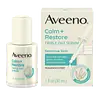What's inside
What's inside
 Key Ingredients
Key Ingredients

 Benefits
Benefits

 Concerns
Concerns

No concerns
 Ingredients Side-by-side
Ingredients Side-by-side

Water
Skin ConditioningBifida Ferment Lysate
Skin ConditioningPEG-8
HumectantPropanediol
SolventBis-PEG-18 Methyl Ether Dimethyl Silane
EmollientMethyl Gluceth-20
HumectantGlycereth-26
HumectantPEG-75
HumectantButylene Glycol
HumectantAdansonia Digitata Seed Extract
Skin ConditioningTripeptide-32
Skin ConditioningSodium Hyaluronate
HumectantYeast Extract
Skin ConditioningLactobacillus Ferment
Skin ConditioningCola Acuminata Seed Extract
Skin ConditioningAnthemis Nobilis Flower Extract
MaskingHydrolyzed Algin
Pantethine
EmollientCaffeine
Skin ConditioningLecithin
EmollientSodium Rna
Skin ConditioningBisabolol
MaskingSqualane
EmollientGlycerin
HumectantOleth-3 Phosphate
Caprylyl Glycol
EmollientOleth-3
EmulsifyingOleth-5
EmulsifyingCholeth-24
EmulsifyingHydrogenated Lecithin
EmulsifyingJojoba Wax PEG-120 Esters
Ceteth-24
CleansingTocopheryl Acetate
AntioxidantCarbomer
Emulsion StabilisingTriethanolamine
BufferingTetrasodium EDTA
BHT
AntioxidantXanthan Gum
EmulsifyingPotassium Sorbate
PreservativeDisodium EDTA
Phenoxyethanol
PreservativeCI 14700
Cosmetic ColorantCI 19140
Cosmetic ColorantWater, Bifida Ferment Lysate, PEG-8, Propanediol, Bis-PEG-18 Methyl Ether Dimethyl Silane, Methyl Gluceth-20, Glycereth-26, PEG-75, Butylene Glycol, Adansonia Digitata Seed Extract, Tripeptide-32, Sodium Hyaluronate, Yeast Extract, Lactobacillus Ferment, Cola Acuminata Seed Extract, Anthemis Nobilis Flower Extract, Hydrolyzed Algin, Pantethine, Caffeine, Lecithin, Sodium Rna, Bisabolol, Squalane, Glycerin, Oleth-3 Phosphate, Caprylyl Glycol, Oleth-3, Oleth-5, Choleth-24, Hydrogenated Lecithin, Jojoba Wax PEG-120 Esters, Ceteth-24, Tocopheryl Acetate, Carbomer, Triethanolamine, Tetrasodium EDTA, BHT, Xanthan Gum, Potassium Sorbate, Disodium EDTA, Phenoxyethanol, CI 14700, CI 19140
Water
Skin ConditioningGlycerin
HumectantButylene Glycol
HumectantBis-PEG-18 Methyl Ether Dimethyl Silane
EmollientIsodecyl Neopentanoate
EmollientPentaerythrityl Tetraethylhexanoate
EmollientEthylhexylglycerin
Skin ConditioningPhenoxyethanol
PreservativeAmmonium Acryloyldimethyltaurate/Vp Copolymer
Chlorphenesin
AntimicrobialDimethicone
EmollientSuccinoglycan
Skin ConditioningChrysanthemum Parthenium Flower/Leaf/Stem Juice
AntioxidantAvena Sativa Kernel Flour
AbrasiveAvena Sativa Kernel Oil
Skin ConditioningAcrylates/C10-30 Alkyl Acrylate Crosspolymer
Emulsion StabilisingDimethiconol
EmollientSodium Hydroxide
BufferingAvena Sativa Kernel Extract
AbrasiveWater, Glycerin, Butylene Glycol, Bis-PEG-18 Methyl Ether Dimethyl Silane, Isodecyl Neopentanoate, Pentaerythrityl Tetraethylhexanoate, Ethylhexylglycerin, Phenoxyethanol, Ammonium Acryloyldimethyltaurate/Vp Copolymer, Chlorphenesin, Dimethicone, Succinoglycan, Chrysanthemum Parthenium Flower/Leaf/Stem Juice, Avena Sativa Kernel Flour, Avena Sativa Kernel Oil, Acrylates/C10-30 Alkyl Acrylate Crosspolymer, Dimethiconol, Sodium Hydroxide, Avena Sativa Kernel Extract
 Reviews
Reviews

Ingredients Explained
These ingredients are found in both products.
Ingredients higher up in an ingredient list are typically present in a larger amount.
Bis-Peg-18 Methyl Ether Dimethyl Silane belongs to the siloxanes and silicones classes. It is synthetically created and has a waxy composition.
This ingredient is a humectant and emollient, meaning it helps hydrate the skin. Humectants draw moisture to your skin, while emollients prevent moisture from escaping.
Butylene Glycol (or BG) is used within cosmetic products for a few different reasons:
Overall, Butylene Glycol is a safe and well-rounded ingredient that works well with other ingredients.
Though this ingredient works well with most skin types, some people with sensitive skin may experience a reaction such as allergic rashes, closed comedones, or itchiness.
Learn more about Butylene GlycolGlycerin is already naturally found in your skin. It helps moisturize and protect your skin.
A study from 2016 found glycerin to be more effective as a humectant than AHAs and hyaluronic acid.
As a humectant, it helps the skin stay hydrated by pulling moisture to your skin. The low molecular weight of glycerin allows it to pull moisture into the deeper layers of your skin.
Hydrated skin improves your skin barrier; Your skin barrier helps protect against irritants and bacteria.
Glycerin has also been found to have antimicrobial and antiviral properties. Due to these properties, glycerin is often used in wound and burn treatments.
In cosmetics, glycerin is usually derived from plants such as soybean or palm. However, it can also be sourced from animals, such as tallow or animal fat.
This ingredient is organic, colorless, odorless, and non-toxic.
Glycerin is the name for this ingredient in American English. British English uses Glycerol/Glycerine.
Learn more about GlycerinPhenoxyethanol is a preservative that has germicide, antimicrobial, and aromatic properties. Studies show that phenoxyethanol can prevent microbial growth. By itself, it has a scent that is similar to that of a rose.
It's often used in formulations along with Caprylyl Glycol to preserve the shelf life of products.
Water. It's the most common cosmetic ingredient of all. You'll usually see it at the top of ingredient lists, meaning that it makes up the largest part of the product.
So why is it so popular? Water most often acts as a solvent - this means that it helps dissolve other ingredients into the formulation.
You'll also recognize water as that liquid we all need to stay alive. If you see this, drink a glass of water. Stay hydrated!
Learn more about Water